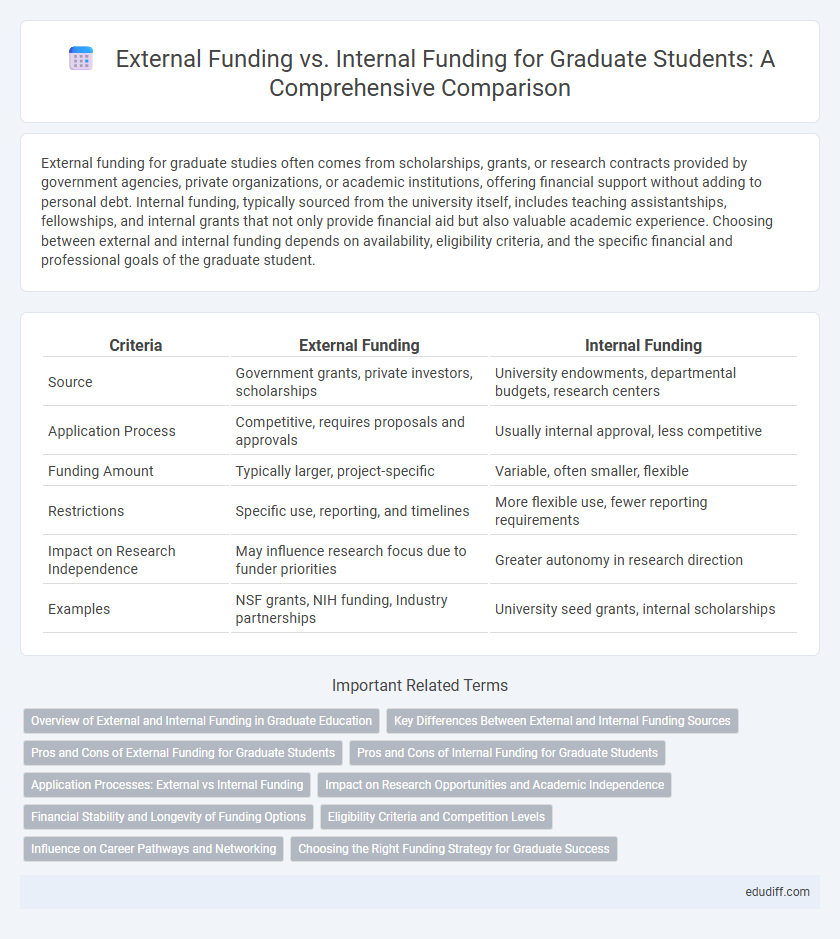External funding for graduate studies often comes from scholarships, grants, or research contracts provided by government agencies, private organizations, or academic institutions, offering financial support without adding to personal debt. Internal funding, typically sourced from the university itself, includes teaching assistantships, fellowships, and internal grants that not only provide financial aid but also valuable academic experience. Choosing between external and internal funding depends on availability, eligibility criteria, and the specific financial and professional goals of the graduate student.
Table of Comparison
| Criteria | External Funding | Internal Funding |
|---|---|---|
| Source | Government grants, private investors, scholarships | University endowments, departmental budgets, research centers |
| Application Process | Competitive, requires proposals and approvals | Usually internal approval, less competitive |
| Funding Amount | Typically larger, project-specific | Variable, often smaller, flexible |
| Restrictions | Specific use, reporting, and timelines | More flexible use, fewer reporting requirements |
| Impact on Research Independence | May influence research focus due to funder priorities | Greater autonomy in research direction |
| Examples | NSF grants, NIH funding, Industry partnerships | University seed grants, internal scholarships |
Overview of External and Internal Funding in Graduate Education
External funding in graduate education primarily includes scholarships, government grants, private fellowships, and industry sponsorships that provide financial support from sources outside the institution. Internal funding typically consists of university-provided assistantships, tuition waivers, and institutional scholarships designed to support graduate students directly through the academic institution. Both funding types are crucial for reducing the financial burden of graduate studies and often influence students' research opportunities and academic focus.
Key Differences Between External and Internal Funding Sources
External funding sources often include government grants, private investors, and crowdfunding platforms, providing substantial capital but usually requiring formal application processes and repayment terms. Internal funding relies on a graduate's personal savings, family contributions, or income from part-time work, offering more control and fewer obligations but limited financial capacity. Understanding these key differences helps graduates strategically choose funding options based on accessibility, cost, and long-term financial impact.
Pros and Cons of External Funding for Graduate Students
External funding for graduate students offers substantial financial support, often covering tuition and living expenses, which enables full-time focus on research without employment distractions. However, reliance on external sources can introduce challenges such as competitive application processes, strict grant requirements, and potential limitations on research scope imposed by funding agencies. This funding type may also come with obligations for reporting and deliverables that can affect academic freedom and project timelines.
Pros and Cons of Internal Funding for Graduate Students
Internal funding for graduate students offers advantages such as streamlined application processes, guaranteed financial support, and stronger alignment with university research priorities, enhancing academic focus. However, limitations include restricted funding amounts, increased competition among students, and potential dependency on institutional politics or changing budget allocations. This funding source may also limit exposure to external networks and diverse funding opportunities that external funding typically provides.
Application Processes: External vs Internal Funding
External funding application processes often require detailed proposals, competitive peer reviews, and strict adherence to agency guidelines, which can be time-consuming and highly selective. Internal funding typically involves streamlined application procedures within the institution, focusing on alignment with organizational priorities and quicker decision timelines. Graduate students should carefully assess eligibility criteria and required documentation to optimize their chances in both funding contexts.
Impact on Research Opportunities and Academic Independence
External funding often expands research opportunities by providing access to larger budgets, advanced resources, and collaborative networks beyond the university. Internal funding supports academic independence by enabling researchers to pursue innovative, high-risk projects without the stringent constraints commonly imposed by external sponsors. Balancing external grants and internal funds optimizes both resource availability and scholarly autonomy, enhancing the overall quality and impact of graduate research.
Financial Stability and Longevity of Funding Options
External funding sources, such as grants, scholarships, and industry sponsorships, provide graduate students with substantial financial resources but often come with uncertainty due to competitive application processes and limited renewal guarantees. Internal funding options, including university fellowships and departmental stipends, typically offer more consistent and reliable support, enhancing financial stability throughout the graduate program. Securing a balanced combination of both external and internal funding optimizes longevity and reduces the risk of financial interruptions during critical research periods.
Eligibility Criteria and Competition Levels
External funding often requires candidates to meet stringent eligibility criteria such as academic excellence, specific research proposals, or affiliation with certain institutions, making the application highly competitive across a broad pool of applicants. Internal funding typically prioritizes current graduate students with demonstrated commitment to their program, presenting less competitive but more narrowly focused eligibility requirements. Understanding these differences helps graduates strategically target funding sources aligned with their qualifications and research goals.
Influence on Career Pathways and Networking
External funding offers graduate students access to diverse professional networks and industry connections, significantly enhancing career opportunities beyond academia. Internal funding, typically provided through university resources, strengthens ties within academic departments and facilitates collaboration with faculty, directly influencing research-focused career pathways. Both funding sources shape skill development and professional visibility, but external funding often accelerates entrance into broader career fields.
Choosing the Right Funding Strategy for Graduate Success
Selecting the appropriate funding strategy significantly influences graduate success by balancing external funding sources such as scholarships, grants, and fellowships with internal funding from university resources or assistantships. Understanding the advantages of external funding--like financial independence and broader networking opportunities--versus internal funding that often provides more direct academic support can optimize resource allocation. Tailoring the funding approach to align with personal research goals, financial needs, and career aspirations enhances the overall graduate experience and outcomes.
External Funding vs Internal Funding Infographic

 edudiff.com
edudiff.com